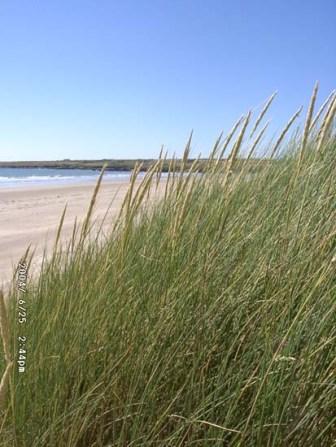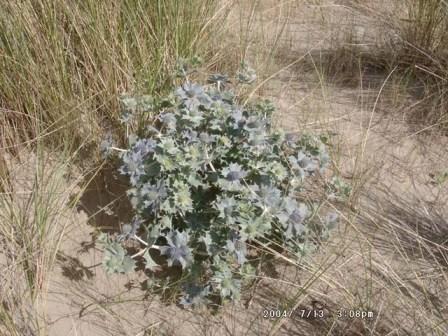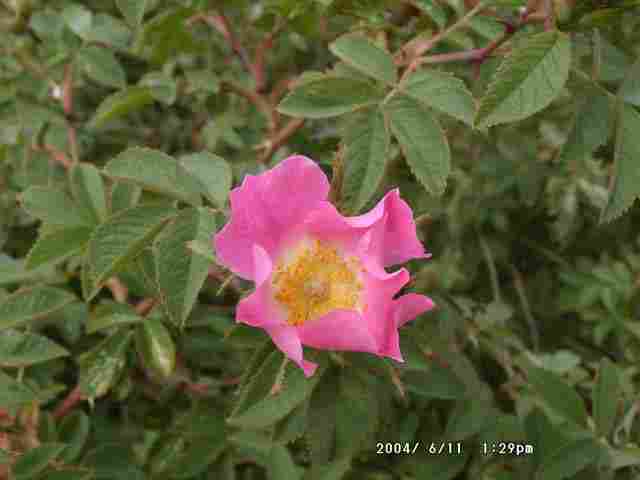Tywyn Aberffraw has 9 special features:
- Coastal landforms and the processes controlling beach and dune development
- Areas of semi-fixed/fixed dune grassland communities.
- Areas of wet dune “slack” (valleys between dunes) and mire communities
- Areas of open water (Lyn Coron)
- A range of saltmarsh communities from the lower to the upper zones.
- Populations of nationally rare and scarce bryophytes (lower plants) including petalwort.
- Populations of nationally rare and scarce vascular plants (higher plants).
- An assemblage of invertebrate species.
As well as the features listed above, Tywyn Aberffraw has other habitats/earth science features that contribute to the special interest. These include the Afon Ffraw and small areas of dune heath and the rare sand shrimp Gammarus chevreuxi. This mixture of habitats is important for much of the wildlife, including its use by foraging chough, and these too are key components of the special interest of the site. Unless specified below, management of this site should aim to look after these habitats as well as the listed features of interest.
What do we want Tywyn Aberffraw to look like?
This important coastal landscape should show the natural processes of sand movement and the beach, dune and slack landforms arising from these. These land-forming processes also create the physical template upon which biological features develop.
 |
 |
| Dune slack ©D Perkins | Foredunes ©D Perkins |
 |
The site should exhibit typical sand dune and estuary vegetation, normally including a strandline, foredunes, mobile and fixed dunes, humid dune slacks and saltmarsh. These will vary in their proportion and location in response to the naturally changing landforms. There should normally be a strandline at some location on the shore each summer, areas of mobile dune “blowout” and areas of newly formed wet slack to provide early successional phases of these habitats. Dune woodland and scrub, composed of native species, could be permitted to develop on inland parts of the fixed dunes. Dune heath (with heather and sand sedge and often an interesting lichen component) should be maintained and encouraged wherever it occurs. |
| Sea holly (©D Perkins) |
The site should support viable populations of petalwort along with other rare and uncommon native species (both plants and animals) typical of these habitats. The site should also support feeding chough and there should be breeding populations of, notably, lapwing and skylark.
Llyn Coron should be a clear-water lake supporting a rich aquatic flora and fauna, including eight-stamened waterwort and hairlike pondweed and swan mussel while the Afon Ffraw remains free to meander naturally across the sand plan and supports river water crowfoot.
This should be achieved through a holistic approach to management which recognises that critical processes, such as sediment supply and deposition, groundwater movement, plant and animal dispersion, occur on a landscape scale. Tywyn Aberffraw is a Common with a long history of livestock grazing which, along the rabbits, has been an important factor in the evolution of the present landscape.
What management is needed on Tywyn Aberffraw and why?
Although Tywyn Aberffraw is an excellent place for wildlife/geology it will only remain so if the necessary management continues. CCW’s aim is to work with you to ensure that this management is carried out.
What does this mean in practice?
There are many factors that could damage the special features at Tywyn Aberffraw if they are not properly managed. These are the ones we regard as most important:
Dune Processes: Beaches and sand dune systems experience natural fluctuations of erosion and deposition and these, particularly the cyclical erosion and redevelopment of the frontal dunes, should be welcomed. Nothing should be done to significantly hinder this process. Structures such as groynes, slipways or other coastal defences which impede natural sediment movement should be resisted unless seriously threatening the roads on the site. Livestock grazing, which assists rabbits in the creation of areas of bare sand and possible new slack initiation, should be continued. High recreational visitor numbers can caused excessive erosion. Dune protection measures such as fencing, stockades etc can be detrimental to natural geomorphological processes and should be avoided wherever possible.
The beach strandline is important in initiating new dunes each year and should not be removed during “beach cleaning” operations.
Nutrients: Dune soils are characterised by low levels of nutrients (N,P,K,) and high levels of calcium. Fertilisers, including atmospheric Nitrogen (NOx) pollution, encourage the growth of coarse grasses at the expense of the desired species. Intensive cattle feeding, for example with silage, can have a similar impact. The use of any form of artificial fertiliser should therefore be avoided. Wind erosion and rabbit burrowing ensures that calcareous (shelly) sand is regularly brought to the surface to replace acid soil layer.
Grazing: Grazing removes excess herbage and reduces competition from coarse grasses or scrub, allowing typical sand dune species to flourish. Grazing with ponies, cattle or sheep also enables rabbits to establish sustainable colonies (they cannot maintain a viable population in the absence of larger grazing animals) creating a patchwork of sward height. The early sand grass and some other rarities are particularly associated with short rabbit grazed turf and scrapes. The warm bare sand associated with hoofed animals and rabbits is important for many invertebrates and their predators and creates opportunities for renewed dune movement. Dung from grazing animals is an important resource for invertebrates (and thereby for insectivorous birds including chough) and for fungi. Therefore the use of parasite drenches should be avoided or minimised. Livestock have grazed here for centuries, however in recent years stock levels have declined, partly due to the absence of cattle grids to prevent stock from wandering off-site so that commoners are reluctant to graze their stock here.
 |
Scrub: At the rear of the site gorse has developed and may enable scrub and trees to develop. This should be permitted but control may be required in some areas to prevent it smothering valued heathland communities. Areas of non-native scrub which threaten to smother the natural vegetation (eg. Sea buckthorn or Japanese rose) should be eliminated. |
| Japanese rose (©J B Ratcliffe) |
Groundwater: Dune slacks indicate the water-table at the time of formation (wind does not scour wet sand) and they should flood in normal winters to provide conditions necessary for species such as petalwort and other rarities. Drainage ditches may have lowered water levels across part of the site, affecting these valuable “slack” areas. Similarly the dredging of the Afon Ffraw below Llyn Coron may have affected wet slack communities adjacent to the river by lowering the water table. Infilling or damming drains and ditches may help to restore groundwater levels.
Water quality: Nutrients such as phosphate and nitrate in the water catchment of Llyn Coron leads to increased levels of phytoplankton algal growth, which shades out natural species, destabilises the lake ecosystem and can cause fish-kills. Efforts to reduce agricultural and domestic pollution of watercourses within the catchment must be maintained. Bottom feeding fish such as bream and tench muddy the water and accentuate nutrient problems and should not be introduced. Brown trout are an essential host in the life cycle of swan mussels and their migration routes and breeding grounds should be maintained.
Finally:Our knowledge of wildlife is far from complete. It is possible that new features of value may appear and new management issues may arise in the future, whilst other issues may disappear. This statement is written with the best information we have now, but may have to change in the future as our understanding improves. Any information you can provide on the wildlife of your site, its management and its conservation would be much appreciated.
If you would like to discuss any aspect of your SSSI, or have any concerns about your SSSI, please contact your local CCW office.
Your local office is;
Cyngor Cefn Gwlad Cymru/Countryside Council for Wales
North Region Office,
Llys y Bont,
Ffordd y Parc,
Parc Menai,
Bangor,
Gwynedd, LL57 4BN,
Telephone: 01248 672500
Fax: 01248 679259